Practicing the CBSE Sample Papers for Class 12 Biology with Solutions Set 1 allows you to get rid of exam fear and be confident to appear for the exam.
CBSE Sample Papers for Class 12 Biology Set 1 with Solutions
Time: 3 Hours.
Max. Marks: 70
General Instructions:
- All questions are compulsory.
- The question paper has five sections and 33 questions. All questions are compulsory.
- Section-A has 16 questions of 1 mark each; Section- B has 5 questions of 2 marks each; Section- C has 7 questions of 3 marks each; Section- D has 2 case-based questions of A marks each; and Section- E has 3 questions of 5 marks each.
- There is no overall choice. However, internal choices have been provided in some questions. A student has to attempt only one of the alternatives in such questions.
- Wherever necessary, neat and properly labeled diagrams should be drawn.
Section – A (16 Marks)
Question 1.
An infertile couple was advised to undergo in vitro fertilization by the doctor. Out of the options given below, select the correct stage for transfer to the fallopian tube for successful results? [1]
(a) Zygote only
(b) Zygote or early embryo upto 8 blastomeres
(c) Embryos with more than 8 blastomeres
(d) Blastocyst Stage
Answer:
(b) Zygote or early embryo upto 8 blastomeres
Explanation: In the in vitro fertilization, either zygote or the early embryo up to 8 cell stage is transferred to the fallopian tube.
Question 2.
Given below are four contraceptive methods and their modes of action. Select the correct match: [1]
| Method | Mode of action | ||
| (a) | Condom | (i) | Ovum not able to reach Fallopian tube |
| (b) | Vasectomy | (ii) | Prevents ovulation |
| (c) | Pill | (iii) | Prevents sperm reaching the cervix |
| (d) | Tubectomy | (iv) | Semen contains no sperms |
(a) (a)-(i), (b)-(ii), (c)-(iii), (d)-(iv)
(b) (a)-(ii), (b)-(iii), (c)-(iv), (d)-(i)
(c) (a)-(iii), (b)-(iv), (c)-(ii), (d)-(i)
(d) (a)-(iv), (b)-(i), (c)-(iii), (d)-(ii)
Answer:
(c) (a)-(iii), (b)-(iv), (c)-(ii), (d)-(i)
Explanation: Contraception is an artificial method or technique, mainly used to prevent pregnancy as a consequence of sexual intercourse. Condoms are barrier contraceptives that are used to prevent pregnancy by blocking sperm from entering the uterus.
Both men and women could be surgically operated on, to prevent fertilization. For women, the process is called Tubal ligation/Tubectomy and for men, it is called Vasectomy.
Vasectomy involves the cutting and sealing of the vas deferens so that the sperms do not enter the ejaculation stream. Pills are hormonal methods of birth control that use hormones to regulate or stop ovulation and prevent pregnancy.
Question 3.
Which of the following amino acid residues will constitute the histone core? [1]
(c) Glutamine and Lysine
(d) Asparagine and Glutamine
(a) Lysine and Arginine
(b) Asparagine and Arginine
Answer:
(a) Lysine and Arginine
Explanation: Nucleosomes are the basic unit of DNA packaging which consists of a segment of DNA wrapped in sequence around eight histone protein core.
Histones are positively charged small alkaline proteins which have a high amount of basic amino acids (arginine and lysine) that provide positive charge to the histones.
Question 4.
Evolutionary convergence is development of a: [1]
(a) Common set of functions in groups of different ancestry.
(b) Dissimilar set of functions in closely related groups.
(c) Common set of structures in closely related groups.
(d) Dissimilar set of functions in unrelated groups.
Answer:
(a) Common set of functions in groups of different ancestry.
Explanation: The development of similar traits or structures among different groups of organisms is called convergent evolution. This occurs due to the similar environmental conditions. They are called the analogous organs and thus represent the convergent evolution.
Question 5.
Apis mellifera are killer bees possessing toxic bee venom. Identify the treatment and the type of immunity developed from the given table to treat a person against the venom of this bee. [1]
| Remedy | Immunity | |
| (a) | Inactivated proteins | Active |
| (b) | Proteins of the venom | Passive |
| (c) | Preformed antibodies | Passive |
| (d) | Dead micro-organisms | Active |
Answer:
(c) Preformed antibodies – Passive
Explanation: Artificial passive immunity is a process when preformed antibodies are delivered directly into the body. It offers a prompt immunological response.
In case of Apis mellifera bites, the injection which is given to the patients, contains preformed antibodies against venom of this bee. This type of immunization is passive immunization.
![]()
Question 6.
Interferons are most effective in making non-infected cells resistant against the spread of which of the following diseases in humans? [1]
(a) Ascariasis
(b) Ringworm
(c) Amoebiasis
(d) AIDS
Answer:
(d) AIDS
Explanation: Virus-infected and tumour cells secrete glycoproteins which protect the non-infected cells from pathogen’s attack, they are known as interferons. Interferons activate macrophages which are natural killer cells, prevent viral replication. They increase antigen presentation to lymphocytes which constantly multiply to eliminate foreign bodies.
Question 7.
Which of the following water samples in the table given below, will have a higher concentration of organic matter? [1]
| Water Sample | Level of pollution | Value of BOD |
| (a) | High | High |
| (b) | Low | Low |
| (c) | Low | High |
| (d) | High | Low |
Answer:
| Water Sample | Level of pollution | Value of BOD |
| (a) | High | High |
Explanation: When there is a high concentration of organic matter in the water, BOD, or the Biological Oxygen Demand, is produced. The decomposing bacteria will be activated to break down this organic substance, and during this process, dissolved oxygen will be consumed.
Therefore, the BOD will increase if there is more organic matter, which will lead to increased pollution in the water body. The dissolved oxygen levels are severely reduced as a result, it destroys aquatic life.
Question 8.
The figure below shows the structure of a plasmid. [1]
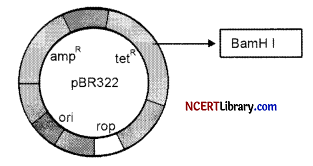
A foreign DNA was ligated at BamHl. The transformants were then grown in a medium containing antibiotics tetracycline and ampicillin. Choose the correct observation for the growth of bacterial colonies from the given table:
| Medium with Tetracycline | Medium with Ampicillin | |
| (a) | Growth | No growth |
| (b) | No growth | Growth |
| (c) | No growth | No growth |
| (d) | Growth | Growth |
Answer:
| Medium with Tetracycline | Medium with Ampicillin | |
| (b) | No growth | Growth |
Explanation: Tetracycline resistance or ampicillin resistance genes can be inactivated by inserting DNA at particular restriction sites, a process known as insertional inactivation.
The pBR322 tetracycline site is also known as the BamH1 site. The resistance gene is altered when foreign DNA is put into the BamH1 site, making the DNA susceptible to tetracycline. However, the gene responsible for Ampicillin resistance is still active, so the recombinant shows growth on ampicillin but not on tetracycline.
Question 9.
Swathi was growing a bacterial colony in a culture flask under ideal laboratory conditions where the resources are replenished. Which of the following equations will represent the growth in this case?
(Where population size is N, birth rate is b, death rate is d, unit time period is t, and carrying capacity is K). [1]
(a) dN/dt = KN
(b) dN/dt = rN
(c) dN/dt = rN(K-N/K)
(d) dN/dt = r N(K + N/K)
Answer:
(b) dN/dt = r N
Explanation: Growing a bacterial colony in a culture flask under ideal laboratory conditions where the resources are replenished will show exponential growth in Log phase.
The formula of exponential growth is dN/dt = rN where dN/dt is the rate of change in population size, r is the biotic potential and N is the population size.
The sea anemone provides the hermit erab with protection from predators, and in exchange, the hermit crab gives the sea anemone food. This kind of interaction is an illustration of symbiotic commensalism.
Question 10.
Sea anemone gets attached to the surface of the hermit crab. The kind of population interaction exhibited in this case is: [1]
(a) Amensalism.
(b) Commensalism.
(c) Mutualism.
(d) Parasitism.
Answer:
(b) Commensalism.
Explanation: Hermit crabs and sea anemones have a symbiotic relationship and peacefully coexist. Commensalism is a sort of symbiotic interaction where neither the hermit crab nor the sea anemone suffer any negative effects.
![]()
Question 11.
Which of the following food chains is the major conduit for energy flow in terrestrial and aquatic ecosystems respectively? [1]
| Terrestrial Ecosystem | Aquatic Ecosystem |
| (a) Grazing | Grazing |
| (b) Detritus | Detritus |
| (c) Detritus | Grazing |
| (d) Grazing | Detritus |
Answer:
(c) Detritus Grazing
Explanation: In an aquatic ecosystem, Grazing food chain is the main conduit of energy because it is the chief form of energy transfer where the chain begins with the primary producers like phytoplankton, which are eaten by the zooplanktons.
The zooplankton are eaten by different fishes which are eaten by bigger fishes or birds like Pelicans or Cranes. In a terrestrial ecosystem, detritus food chains (DFC) is a major conduit of energy flow.
As an organism does or produces biological matter or waste, it enters DFC. Further steps include recycling of nutrient and flow of energy in DFC.
Question 12.
Which of the following is an example of ex situ conservation? [1]
(a) Sacred Groves
(b) National Park
(c) Biosphere Reserve
(d) Seed Bank
Answer:
(d) Seed Bank
Explanation: Ex-situ conservation is the method of conservation of all levels of biological diversity outside their natural habitats. Botanical gardens, zoological parks, seed banks, cryopreservation, field gene banks, etc. are examples of it.
Question No. 13 to 16 consist of two statements Assertion (A) and Reason (R). Answer these questions selecting the appropriate option given below:
(a) Both A and R are true and R is the correct explanation of A.
(b) Both A and R are true and R is not the correct explanation of A.
(c) A is true but R is false.
(d) A is false but R is true.
Question 13.
Assertion (A): Apomictic embryos are genetically identical to the parent plant. [1]
Reason (R): Apomixis is the production of seeds without fertilization.
Answer:
(a) Both A and R are true and R is the correct explanation of A.
Explanation: Apomixis is a form of asexual reproduction that mimics sexual reproduction but produces seeds without fertilisation. Since it is an asexual reproduction, the off springs produced are identical to the parent plants.
Question 14.
Assertion (A): When white eyed, yellow bodied Drosophila females were hybridized with red eyed, brown-bodied males; and Fj progeny was intercrossed, F2 ratio deviated from 9 : 3 : 3 : 1.
Reason (R): When two genes in a dihybrid are on the same chromosome, the proportion of parental gene combinations is much higher than the non-parental type. [1]
Answer:
(a) Both A and R are true and R is the correct explanation of A.
Explanation: In Drosophila, the genes for body and eye colour are located on X chromosome. A dihybrid cross parental gene combination is more prevalent than the non-parental kind when two of the genes are located on the same chromosome.
This happens as a result of the physical relationship or linkage of the two genes, whereas non-parental gene combinations happen as a result of gene recombination. As a result, linkage and recombination cause a dihybrid cross’ ratio to depart from the Mendelian ratio ( 9 : 3 : 3 : 1 ).
Question 15.
Assertion (A): Functional ADA cDNA genes must be inserted in the lymphocytes at the early embryonic stage.
Reason (R): Cells in the embryonic stage are mortal, differentiated and easy to manipulate. [1]
Answer:
(c) A is true but R is false.
Explanation: In first step of gene therapy, lymphocytes from the blood of the patient are grown in a culture outside the body. A functional ADA cDNA (using a retroviral vector) is then introduced into these lymphocytes, which are subsequently returned to the patient. As these cells are not immortal, the patient requires periodic infusion of such genetically engineered lymphocytes.
![]()
Question 16.
Given below is the Age Pyramid of population in one of the states in India as per 2011 census. It depicts the male population on the left hand side, female population on the right hand side, newborns towards the base and gradually increasing age groups as we move from base to the top, with the oldest population at the top. Study this pyramid and comment upon the appropriateness of the Assertion and the Reason. [1]
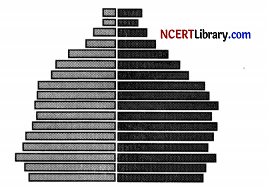
Assertion (A): It is a stable population.
Reason (R): The pre-reproductive and reproductive individuals are almost in equal numbers and the post-reproductive individuals are relatively fewer.
Answer:
(a) Both A and R are true and R is the correct explanation of A.
Explanation: Bell-shaped age pyramids are formed when the pre-reproductive and reproductive individuals are almost in equal numbers or percentages and the post-reproductive individuals are relatively fewer. Such a population is predicted to remain stable.
Section – B (10 Marks)
Question 17.
In the figure given below, parts A and B show the level of hormones which influence the menstrual, cycle. Study the figure and answer the questions that follow: [2]
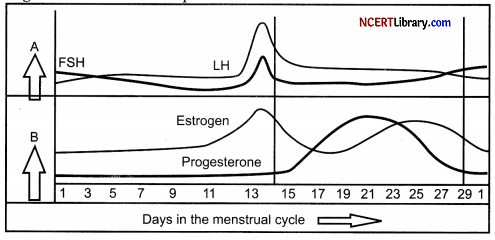
(a) Name the organs which secrete the hormones represented in parts A and B.
(b) State the impact of the hormones in part B on the uterus of the human female during 6 to 15 days of menstrual cycle?
Answer:
(a) A – Pituitary gland; B: Ovary
Follicle-Stimulating Hormone (FSH) and Luteinizing Hormone (LH) are secreted by the anterior pituitary. FSH stimulates the growth of ovarian follicles that secrete estrogen. Progesterone is secreted by the corpus luteum.
(b) Endometrium of the uterus regenerates through proliferation. The secretion of FSH and LH gradually increases during the follicular phase (takes place from 5th to 13th day of the cycle). They stimulate the development of follicles and the release of estrogen from them. Estrogen stimulates the proliferation of the endometrium.
Question 18.
A true breeding pea plant, homozygous dominant for inflated green pods is crossed with another pea plant with constricted yellow pods (ffgg). With the help of Punnett square show the above cross and mention the results obtained phenotypically and genotypically in FI generation? [2]
Answer:
The cross can be represented as shown in the figure.

Phenotype – All Inflated green pods
Genotype -FfGg
Question 19.
During a field trip, one of your friend in the group suddenly became unwell, she started sneezing and / had trouble in breathing. Name and explain the term associated with such sudden responses. What would the doctor recommend for relief? [2]
Answer:
(a) Allergy is the term for this reaction. An allergic reaction is triggered by chemicals known as allergens. Allergy is sort of the body’s immune system overreacting to allergens.
Allergy is due to release of chemicals like histamine and serotonin from mast cells. The antibodies produced in these are IgE type.
(b) Doctors would administer drugs like antihistamines, adrenaline and steroids to reduce the symptoms.
![]()
Question 20.
CTTAAG
GAATTC
(a) What are such sequences called? Name the enzyme used that recognizes such nucleotide sequences.
(b) What is their significance in biotechnology? [2]
Answer:
(a) Palindromic sequences, endonuclease enzyme Palindromic sequences are referred to as the sequence of nucleotides in the DNA duplex or RNA, where the sequence in one strand is the same as the complementary sequence of the other strand when read from the same direction on both the strands, either 5′ to 3′ or 3′ to 5′.
5′- GAATTC- 3′
3′- CTTAAG -5′
Many restriction enzymes or restriction endonucleases identify a specific palindrome site and cut the DNA strands. They mostly cut the DNA, slightly away from the centre of the palindrome and between the same two nitrogenous bases in both the strands.
(b) Restriction enzymes are used in the recombinant DNA technology to insert the desired DNA fragment into the vector forming recombinant DNA molecule.
Question 21.
Given below is a pyramid of biomass in an ecosystem where each bar represents the standing crop available in the trophic level. With the help of an example explain the conditions where this kind of pyramid is possible in nature? [2]

or
Will the pyramid of energy be also of the same shape in this situation? Give reason for your response.
Answer:
(a) An inverted biomass pyramid is a diagram that shows the biomass present in a given area at different trophic levels, with fewer producers at the base of the pyramid than consumers at higher trophic levels.
The biomass pyramid may resemble an inverted pyramid in many aquatic ecosystems. Here the biomass of primary producers is much less than the zooplanktons, which if less than the small fish and the big fish having the maximum biomass.
(b) No, Pyramid of energy is always upright. As energy flows from one trophic level to the next trophic level some amount of energy is lost in each trophic level in the form of heat. Therefore, the pyramid of energy is always upright and can never be inverted.
OR
(a) Draw a pyramid of numbers where a large number of insects are feeding on the leaves of a tree. What is the shape of this pyramid?
(b) Will the pyramid of energy be also of the same shape in this situation? Give reason for your response.
Answer:
(a) Inverted pyramid because a large number of insects feed on one tree

(b) No, the Pyramid of energy is always upright, and can never be inverted because when energy flows from one trophic level to the next trophic level some amount of energy is always lost as heat at each step.
Section – C (21 Marks)
Question 22.
Explain the functions of the following structures in the human male reproductive system. [3]
(a) Scrotum
(b) Leydig cells
(c) Male accessory glands
Answer:
(a) Scrotum: The scrotum, a pouch that houses the testicles, is located outside the abdominal cavity. The scrotum aids in maintaining the testicular temperature needed for spermatogenesis, which is 2-2.5 degrees Celsius below the body’s normal internal temperature.
(b) Leydig cells: Leydig cells synthesise and secrete androgens (testicular hormones). The pituitary gland secretes luteinizing hormone (LH), which stimulates Leydig cells to secrete androgens.
(c) Male accessory glands: Pairs of seminal vesicles, a prostate, and paired bulbourethral glands are among the male accessory glands. The seminal plasma, which is rich in fructose, calcium, and certain enzymes, is made up of the secretions of these glands. The lubrication of the penis is further aided by the secretions of the bulbourethral glands.
Question 23.
State the agent(s) which helps in pollinating in the following plants. Explain the adaptations in these plants to ensure pollination: [3]
(a) Com
(b) Water hyacinth
(c) Vallisneria
Answer:
(a) Com: Com is typically pollinated by the wind, having both male (tassels) and female (silks and ear) flowers. Pollen from the tassels needs to land on the silks in order to create a good crop.
Tassels emerge from the top of the corn plant, then open to disperse pollen on the silks which emerge lower, from the immature corn ear. Each individual silk is a potential kernel of com.
Numerous flowers are packed in an inflorescence; the tassels seen in the corn cob are the stigma and style which wave in the wind to trap pollen grains.
(b) Water hyacinth: The flowers of water hyacinth and water lily emerge above the level of water and are pollinated by insects or wind. In water hyacinth, that is, Eichhornia the flowers are purple in color, attractive and borne in a spike to facilitate pollination by insects.
(c) Vallisneria: With the aid of a lengthy stalk, the mature flower of the Vallisneria emerges on the water’s surface. The pollen is then released onto the water’s surface by the male flower, and when a female bloom rises above the water’s surface, the pollen is piled to the stigma, completing the pollination process.
![]()
Question 24.
(a) Identify the polarity of x to x’ in the diagram below and mention how many more amino acids are expected to be added to this polypeptide chain.
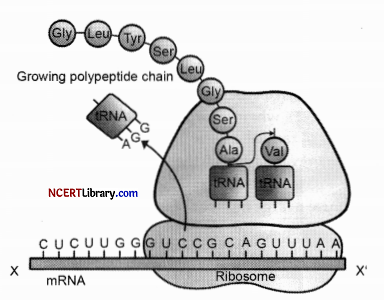
(b) Mention the codon and anticodon for alanine.
(c) Why are some untranslated sequences of bases seen in mRNA coding for a polypeptide? Where exactly are they present on mRNA? [3]
Answer:
(a) Translation is the process of polymerisation of amino acids to form a polypeptide.
x to x’ is 5′ — >3′
UAA is a stop/termination codon. Termination of polypeptide synthesis occurs when a release factor binds to the stop codon. As a result, the polypeptide synthesis or elongation stops releasing the complete polypeptide from the ribosome. Since the next codon on strand is UAA, so no more amino acids will be added.
(b) Codon is GCA Anticodon is CGU
(c) An mRNA has additional sequences that are not translated (untranslated regions or UTR). UTRs are present at both 5′-end (before start codon) and 3′- (after stop codon). They are required for efficient translation process.
Question 25.
(a) How is Hardy-Weinberg’s expression ” (p2 + 2pq + q2) =1″derived? [3]
(b) List any two factors that can disturb the genetic equilibrium.
Answer:
(a) Godfrey Hardy and Wilhelm Weinberg devised an easy equation that may be used to determine the likely genotype frequencies in a population and monitor changes over time.
This has become known as the Hardy-Weinberg equilibrium equation.
In this equation (p2 + 2pq + q2) =1,
p is defined as the frequency of the dominant allele, q as the frequency of the recessive allele for a trait controlled by a pair of alleles (A and a).
In other words, p equals all of the alleles in individuals who are homozygous dominant (AA) and half of the alleles in people who are heterozygous (Aa) for this trait in a population.
In mathematical terms, this is
p = AA + ½ Aa
Likewise, q equals all of the alleles in individuals who are homozygous recessive (aa) and the other half of the alleles in people who are heterozygous (Aa).
q = aa + ½ Aa
Because there are only two alleles in this case, the frequency of one plus the frequency of the other must equal 100%, which is to say
p + q = l
Since this is logically true, then the following must also be correct:
p = i – q
There were only a few short steps from this knowledge for Hardy and Weinberg to realize that the chances of all possible combinations of alleles occurring randomly is
(p + q)2 =1
or more simply
(p2 + 2pq + q2) =1
In this equation, p2 is the predicted frequency of homozygous dominant (AA) people in a population, 2pq is the predicted frequency of heterozygous (Aa) people, and q2 is the predicted frequency of homozygous recessive (aa) ones.
(b) Hardy Weinberg Principle mathematically explains the occurrence and consistency of gene frequency for a particular gene. The principle states that the allelic frequency remains constant through generations and the gene pool remains constant. This phenomenon is called genetic
equilibrium.
The five factors that can effect genetic equilibrium are- gene flow, mutation, genetic drift, genetic recombination and natural selection. All these factors contribute to the change in gene frequency of a species in an area.
![]()
Question 26.
Highlight the structural importance of an antibody molecule with a diagram. Name the four types of antibodies found to give a humoral immune response, mentioning the functions of two of them you have studied. [3]
OR
(a) Explain the Life cycle of Plasmodium starting from its entry in the body of female Anopheles till the completion of its life cycle in humans.
(b) Explain the cause of periodic recurrence of chill and high fever during malarial attack in humans.
Answer:
Antibodies are glycoproteins and have a high level of antigen specificity. They are also known as immunoglobulins (Igs). They are organised in a ‘Y configuration. It is made up of two heavy (H) chains and two light (L) chains, totaling four polypeptide chains.
Hence, the antibody is represented as H2 Lr Disulphide linkages connect the four polypeptide chains to create a ‘Y- shaped structure. The hinge is the area that connects the stem and arms of the antibody.
The variable region and the constant region are two separate areas that are present in each antibody chain. The antigen-binding site is made up of variable sections (paratope). This antibody component identifies the particular antigen and binds to it, creating an antigen-antibody complex.
Antibodies or immunoglobulins(Ig) are of five different isotypes. This classification is on the basis of their H chains. They are IgM, IgG, IgA, IgD, IgE.
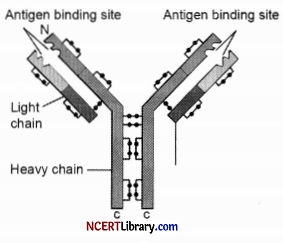
IgA
Usually found in liquids such as breast milk, serum, saliva, fluids of the intestine. IgA in breast milk
protects an infant’s gastrointestinal tract from microbial activity.
IgE
These are present in the linings of the respiratory and intestinal tracts and respond to allergic reactions.
OR
(a) The three stages of the Plasmodium parasite’s complex life cycle are gametocytes, sporozoites, and merozoites.
Stage 1 Gametocytes: When an anopheles mosquito feeds on blood, it transmits male gametocytes known as microgametocytes and female gametocytes known as macro gametocytes. The gametocytes within the mosquito develop into a sporozoite. Inside the mosquito’s gut, the male and female gametocytes mate, and after 15 to 18 days, they form a parasite called sporozoite.
Stage 2 Sporozoites: The sporozoites enter the bloodstream through the saliva of the infected mosquito when it feeds on humans. The sporozoites then move on to the liver cells, where they develop into schizonts. These sporozoites later burst, releasing merozoites.
Stage 3 Merozoites: Each schizont multiplies throughout the course of the following one to two weeks to produce a number of other forms called merozoites. After emerging through the liver, the merozoites re-enter the bloodstream where they target the red blood cells.
The merozoites continue to develop and reproduce while obliterating all blood cells. Some merozoites mature into gametocytes, which are then consumed by a mosquito into the bloodstream and the cycle repeats itself.
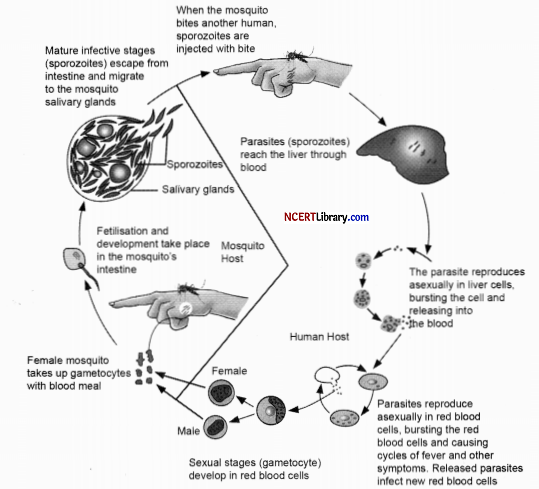
(b) The merozoites’ destruction of the red blood cells triggers the production of chemical haemozoin that results in shiver-inducing chills and fever. Fever and chills that are unbearably chilly are typical signs of malaria in humans.
Question 27.
Carefully observe the given picture. A mixture of DNA with fragments ranging from 200 base pairs to 2500 base pairs was electrophoresed on agarose gel with the following arrangement. [3]
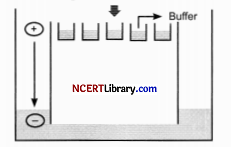
(a) What result will be obtained on staining with ethidium bromide? Explain with reason.
(b) The above set-up was modified and a band with 250 base pairs was obtained at X
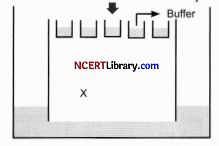
What change(s) were made to the previous design to obtain a band at X? Why did the band appeal at the position X?
Answer:
(a) No bands will be obtained as the sample DNA will remain in the wells. DNA fragments being negatively charged will not move towards negative electrode i.e., cathode. DNA being negatively charged will remain stationed at the positive end/ anode end of the agar block.
(b) (i) Position of the positive electrode anode and the negative electrode cathode was inter-changed, so that negatively charged DNA could move towards anode.
(ii) Shorter strands of DNA move more quickly through the gel than longer strands resulting in the fragments being arranged in order of size.
![]()
Question 28.
(a) There was loss of biodiversity in an ecosystem due to a new construction project in that area. What would be its impact on the ecosystem? State any three.
(b) List any three major causes of loss of biodiversity? [3]
Answer:
(a) Biodiversity Loss is defined as a decline in the biological diversity of a species, an ecosystem, a location, or the entire world. It is frequently referred to as a loss in biodiversity if a species disappears from a particular region or if there is a decrease in the quantity and genetic diversity of any region. A rapid environment change typically causes mass extinctions. An area’s loss of biodiversity may result in:
1. Decrease in plant produces.
2. Decreased ability to withstand environmental changes.
3. A rise in the variability of certain ecosystem processes including water use, plant productivity, disease cycles, and pests.
(b) There is a decline in biodiversity because of:
1. The introduction of exotic species: This can cause an imbalance in biodiversity when they are brought into new natural habitats.
2. Pollution: Human activity affects the environment negatively, changing its chemical and physical makeup, energy flow, and other aspects of the ecosystem.
3. Over-exploitation of resources: When resources are used excessively through hunting, gathering, and other methods, they may run out and biodiversity is lost.
4. Natural disasters: like landslides, cyclones, and floods and avalanches, volcanism, etc., are also responsible for depletion of biological diversity.
Section – D (8 Marks)
Questions No 29 and 30 are case based questions. Each question has subparts with internal choice in one subpart.
Question 29.
Study the Pedigree chart given below and answer the questions that follow: [4]
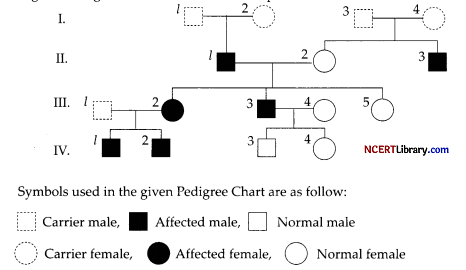
(a) On the basis of the inheritance pattern exhibited in this pedigree chart, what conclusion can you draw about the pattern of inheritance?
(b) If the female is homozygous for the affected trait in this pedigree chart, then what percentage of her sons will be affected?
(c) Give the genotype of offsprings 1,2,3 and 4 in III generation.
OR
(c) In this type of inheritance pattern, out of male and female children which one has less probability of receiving the trait from the parents? Give a reason.
Answer:
(a) X- linked, Recessive trait
1. The trait is more common in males than in females. In the case when mother has the trait, all of her sons also have it (3rd generation).
2. There is no male-to-male transmission.
3. It has the same inheritance patterns as autosomal recessive for human females.
4. The son of a female carrier has a 50 percent chance of having the trait.
5. Mothers of males who have the trait are either heterozygous carriers or homozygous and express the trait.
(b) 100%
In the case when female is homozygous for the affected trait, all of her sons also have it.
(c) In this type of inheritance pattern, out of male and female children which one has less probability of receiving the trait from the parents? Give a reason.
1. mXYORXrY,
2. XrXr
3. XrY,
4. XX
OR
(c) X-linked recessive diseases most often occur in males. Males have only one X chromosome. A single recessive gene on that X chromosome will cause the disease. Females can get an X-linked recessive disorder, but this is very rare.
An abnormal gene on the X chromosome from each parent would be required, since a female has two X chromosomes. The female will get the trait only if the mother is at least a carrier and the father is affected.
![]()
Question 30.
The data below shows the concentration of nicotine smoked by a smoker taking 10 puffs/ minute. [4]
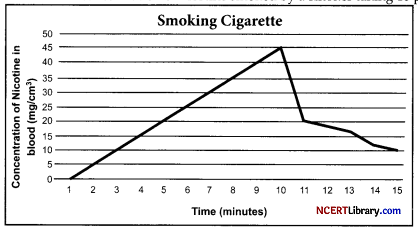
(a) With reference to the above graph explain the concentration of nicotine in blood at 10 minutes.
(b) How will this affect the concentration of carbon monoxide and haembound oxygen at 10 minutes?
(c) How does cigarette smoking result in high blood pressure and increase in heart rate?
OR
(c) How does cigarette smoking result in lung cancer and emphysema?
Answer:
(a) The graph shows peak in concentration of nicotine at 10 minutes. The concentration of nicotine increases steadily in the blood to reach 45mg/cm3.
(b) Smoking increases carbon monoxide (CO) content in the blood and reduces the concentration of haemoglobin-bound oxygen. The formation of carboxyhemoglobin, decreases the oxygen carrying capacity of the blood and inhibits the transport, delivery, and utilization of oxygen by the body.
Haemoglobin prefers to attach to carbon monoxide over oxygen due to the relative strength of their affinities, which is about 230 times more for carbon monoxide than for oxygen.
(c) Nicotine present in tobacco stimulates adrenal gland to release adrenaline and nor-adrenaline into blood circulation, both of which raise blood pressure and increase heart rate.
The increased blood pressure caused by smoking leads to increased risk of heart diseases. In pregnant women nicotine causes retardation of the growth of the foetus.
OR
(c) Benzopyrene present in tobacco smoke is carcinogenic. About 95% victims of lung cancer are due to smoking. Reverse smoking causes oral cancer. In reverse smoking, the burning end of the cigar is kept in the mouth.
Reverse smoking is common in the villages of Andhra Pradesh. Bidi smoking causes cancer of tongue, pharynx (throat), larynx, tonsils and oesophagus. Lip cancer is caused by cigar and pipes.
Tobacco chewing leads to oral cancer. Emphysema is a condition that involves damage to the walls of the air sacs (alveoli) of the lung. Long term contact with smoke causes alveoli to lose their elasticity thus making the movement of gases difficult.
As a result insufficient oxygen is supplied to the body which causes smoker to struggle for breath. Tobacco smoke may break down the walls of alveoli of the lungs, decreasing the surface area for gas exchange, causing emphysema.
Section – E (15 Marks)
Question 31.
Trace the events from copulation to zygote formation in a human female. [5]
OR
Trace the development of a megaspore mother cell to the formation of mature embryo sac in a flowering plant.
Answer:
Semen is discharged into the vagina by the penis during copulation (coitus) (insemination). The swiftly swimming motile sperms travel past the cervix, enter the uterus, and then arrive at the ampullary portion of the fallopian tube.
The ovum released by the ovary is also transported to the ampullary region where fertilization takes place. Only when the ovum and sperm are transferred concurrently to the ampullary region can fertilisation take place. This explains why not all copulations result in fertilisation and conception.
The fusing of a sperm and an ovum is referred to as fertilisation. A sperm contacts the zona pellucida layer of the ovum during fertilisation, causing alterations in the membrane that prevent the passage of further sperms.
As a result, it assures that an ovum can only be fertilised by one sperm. The acrosome’s secretions facilitate sperm entry into the ovum’s cytoplasm via the zona pellucida and plasma membrane.
This causes the secondary oocyte’s meiotic division to be completed. The second meiotic division is also unequal and results in the formation of a second polar body and a haploid ovum (ootid). A diploid zygote is soon created when the haploid nuclei of the sperm and the ovum fuse.
OR
Megasporogenesis is the process by which megaspores develop from the megaspore mother cell.
In the nucellus’ micropylar area, ovules typically distinguish a single megaspore mother cell (MMC). It is a large cell with a conspicuous nucleus and a thick cytoplasm. Megaspores are created during meiotic division of the MMC.
The majority of flowering plants only have one functional megaspore, with the other three degenerating. The female gametophyte only develops from the functioning megaspore (embryosac). The process of creating an embryo sac from a single megaspore is known as monosporic development.
The functioning megaspore’s nucleus divides during mitosis to produce two nuclei, which travel to the opposing poles to create the 2-nucleate embryo sac.
The 4-nucleate and eventually the 8-nucleate stages of the embryo sac are created by two more consecutive mitotic nuclear divisions. These mitotic divisions are strictly free nuclear, meaning that cell wall construction is not immediately followed by nuclear divisions.
Cell walls are formed after the 8-nucleate stage, resulting in the organisation of the typical female gametophyte or embryo sac. Six of the eight nuclei are surrounded by cell walls and organized into cells; the remaining two nuclei, called polar nuclei are situated in the large central cell.
The egg apparatus is made up of three cells that are clustered together at the micropylar end. The egg apparatus consists of one egg cell and two synergids. At the micropylar tip, the synergids contain distinctive cellular thickenings known as filiform apparatus.
The antipodals, which consist of three cells, are located at the chalazal end. The large central cell, as mentioned earlier, has two polar nuclei. Which come to lie below egg apparatus. Thus, a typical angiosperm embryo sac, at maturity, though 8-nucleate is 7-celled.
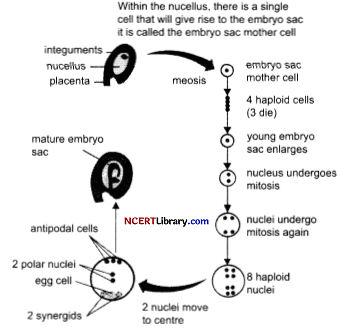
Question 32.
Observe the segment of mRNA given below. [5]
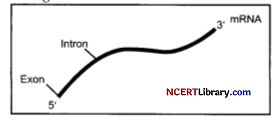
(a) Explain and illustrate the steps involved to make fully processed hnRNA?
(b) Gene encoding RNA Polymerase I and III have been affected by mutation in a cell. Explain its impact on the synthesis of polypeptide, stating reasons.
OR
Study the schematic representation of the genes involved in the lac operon given below and answer the questions that follow:
| P | I | P | 0 | z | y | a |
(a) The active site of enzyme permease present in the cell membrane of a bacterium has been blocked by an inhibitor, how will it affect the lac operon?
(b) The protein produced by the i gene has become abnormal due to unknown reasons. Explain its impact on lactose metabolism stating the reason.
(c) If the nutrient medium for the bacteria contains only galactose; will operon be expressed? Justify your answer.
Answer:
(a) Heterogeneous nuclear RNA or hnRNA is a term that encompasses various types and sizes of RNAs that are found in the eukaryotic cell nucleus. hnRNA the precursor of mRNA.
It is the primary transcript transcribed by RNA polymerase II in eukaryotes. When heterogeneous nuclear RNA undergoes modifications and processing it will give rise to the mature mRNA that has the inherent code for the protein synthesis (amino acid code).
It contains exons as well as introns, which needs to be spliced out. Processing involves splicing capping and tailing. The fully processed mRNA is transported from the nucleus into the cytoplasm
for translation.
Eukaryotic hnRNA undergoes following processes to become a functional mRNA.
1. The hnRNA is first undergoes a process called splicing. During splicing, the introns are removed from the mRNA and exons are joined in a defined order.
2. Methyl guanosine triphosphate is added to the 5′-end of hnRNA. This process is called capping.
3. Adenylate residues (200-300) are added at 3′-end in a template independent manner. This process is called tailing.
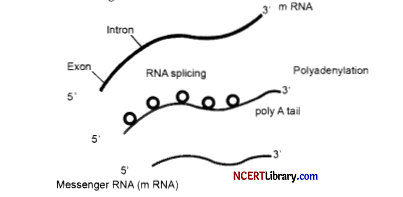
(b) The polypeptide synthesis is halted since the translation process will not proceed. The reason for the above is: RNA polymerase I transcribes rRNAs which is the cellular factory for protein synthesis.
RNA polymerase III helps in transcription of tRNA which is the adaptor molecule that transfers amino acids to the site of protein synthesis. In eukaryote cells, RNA polymerase III (also called Pol III) is a protein that transcribes DNA to synthesize ribosomal 5S rRNA, tRNA and other small RNAs.
OR
(a) Lactose is not transported into the cell when the active site of the bacterial cell membrane enzyme permease has been inhibited by an inhibitor.
The lac operon won’t be turned on because lactose is the inducer. When lactose is not available, the lac repressor binds tightly to the operator, preventing transcription by RNA polymerase.
(b) Mutations in regulator genes can affect the expression of all structural genes in an operon. lac i is the regulator gene of the lac operon. This gene is located just upstream of the promoter region for the lac structural genes. The protein that is formed by the lac i gene is known as the lac repressor.
Since the repressor protein synthesized by the i gene is abnormal, it will not bind to the operator region of the operon, resulting in a continuous state of transcription process.
(c) The lac operon of E. coli contains genes involved in lactose metabolism. It’s expressed only when lactose is present and glucose is absent. If the medium contains only galactose, operon will not be expressed, because galactose is not an inducer instead it is a product of lactose metabolism.
![]()
Question 33.
Oil spill is a major environmental issue. It has been found that different strains of Pseudomonas bacteria have genes to break down the four major groups of hydrocarbons in oil. [5]
Trials are underway to use different biotechnological tools to incorporate these genes and create a genetically engineered strain of Pseudomonas – a ‘super-bug’, to break down the four major groups of hydrocarbons in oil. Such bacteria might.be sprayed onto surfaces polluted with oil to clean thin films of oil.
(a) List two advantages of using bacteria for such biotechnological studies?
(b) For amplification of the gene of interest PCR was carried out. The PCR was run with the help of polymerase which was functional only at a very low temperature. How will this impact the efficiency of the PCR? Justify.
(c) If such bacteria are sprayed on water bodies with oil spills, how will this have a positive or negative effect on the environment? Discuss.
OR
Insects in the Lepidopteran group lay eggs on maize crops. The larvae on hatching feed on maize leaf and tender cob. In order to arrest the spread of three such Lepidopteran pests, Bt maize crops were introduced in an experimental field.
A study was carried out to see which of the three species of lepidopteran pests was most susceptible to Bt genes and its product.
The lepidopteran pests were allowed to feed on the same Bt-maize crops grown on 5 fields (A-E).
The graph below shows the leaf area damaged by these three pests after feeding on maize leaves for five days.
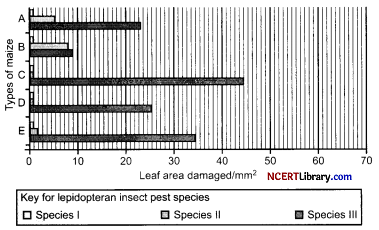
Insect gut pH was recorded as 10, 8 and 6 respectively for Species I, II and III respectively.
(a) Evaluate the efficacy of the Bt crop on the feeding habits of the three species of stem borer and suggest which species is least susceptible to Bt toxin.
(b) Which species is most susceptible to Bt-maize, explain why?
(c) Using the given information, suggest why similar effect was not seen in the three insect species.
Answer:
(a) 1. Oil spills will degrade much more quickly if bacteria and nutrients are added, and this method has less of an impact on the environment than other cleanup techniques.
2. Communities will become more robust as a result, and they will recover more swiftly from the spill. Moreover, bacteria can be easily cultured on large scale and can be easily transformed using recombinant DNA technology.
(b) The gene cannot be amplified by PCR. The ability of the polymerase enzyme to resist high temperatures, which are required for unwinding, separating, and denaturing DNA strands, would be compromised if it denatures at low temperatures.
As a result, the next step of expanding the primers utilizing the reaction’s given nucleotides and the genomic DNA as template won’t take place.
(c) If genetically modified bacteria are sprayed on water bodies with oil spills, this can have a both positive and negative effect on the environment.
Bioremediation is an ecofriendly and economical technique for cleaning and restoration of sites that have been contaminated with the petroleum products and other crude oils with no generation of secondary pollution.
Microorganisms particularly bacteria and fungi are the major natural recycling agents. They have the ability to transform hydrocarbons into energy and use them for energy and growth purposes.
However, the bacteria can mutate and can harm other organisms. They can conjugate with other non-virulent forms and make them super bugs with detrimental effect and for a longer duration it may reduce the dissolved oxygen and leading to mortality of aquatic organisms.
OR
(a) The graph shows that species III have caused maximum damage to maize leaf, Hence, Species III is least susceptible.
(b) Species I is most susceptible to Bt-Maize, since it has caused least damage to maize. Bt toxin protoxins are converted into an active form in the gut which solubilises the toxin crystals.
The activated toxin binds to the surface of midgut epithelial cells and create pores that cause cell swelling and lysis and eventually cause death of the insect.
(c) Insect species I and II have alkaline pH of gut which solubilizes the insecticidal protein crystals of protoxin and makes it active. Species III has an acidic and the protoxin continues to remain in an inactive form doing no harm to insect species III.